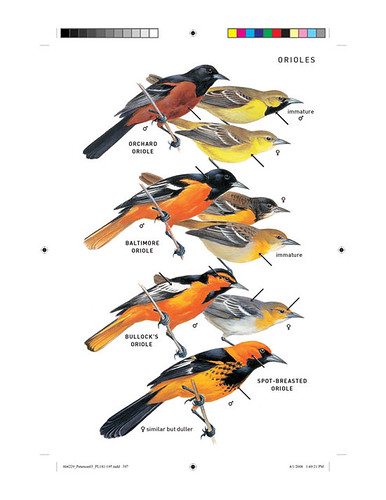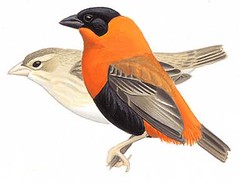tags: book review, Peterson Field Guide, field guide to the birds, birding, North American birds, Roger Tory Peterson
 No one has done more to advance and popularize birdwatching than artist and naturalist, Roger Tory Peterson (RTP), who published his first field guide to the birds in 1934 at the ripe old age of 26. No doubt, many of you probably grew up using RTP's seminal field guides to identify wild birds, but did you know that the Peterson Field Guide to Western Birds and the Peterson Field Guide to Eastern Birds were combined into one large Sibley-esque type volume for the first time? This new book, the Peterson Field Guide to Birds of North America, was published by Houghton Mifflin at the end of August 2008, on the centennial of RTP's birth.
No one has done more to advance and popularize birdwatching than artist and naturalist, Roger Tory Peterson (RTP), who published his first field guide to the birds in 1934 at the ripe old age of 26. No doubt, many of you probably grew up using RTP's seminal field guides to identify wild birds, but did you know that the Peterson Field Guide to Western Birds and the Peterson Field Guide to Eastern Birds were combined into one large Sibley-esque type volume for the first time? This new book, the Peterson Field Guide to Birds of North America, was published by Houghton Mifflin at the end of August 2008, on the centennial of RTP's birth.
This new 532-page field guide is printed on heavy paper and bound in a tough vinyl cover, suitable for the field. It includes the all familiar paintings by RTP, including those helpful arrows that point to diagnostic field marks for each species. The color in the paintings is excellent and they are sharp and clear on the page. Because the book is larger than the original field guides, the paintings are correspondingly larger, too. All the paintings were digitally enhanced by artist, Michael DiGiorgio, so they more accurately represent what a person sees in the field (below);
Oriole plate (sample),
Roger Tory Peterson,
Field Guide to the Birds of North America [larger view].
Image courtesy of Houghton Mifflin publishers.
Due to the advent of DNA-based phylogenies, avian evolutionary relationships are especially fluid at this time, so the paintings were rearranged to reflect the latest taxonomic changes to bird groups.
Forty new paintings by the artist, Michael O'Brien, were added to this field guide to either replace art that RTP painted over, as in the case of the Canyon Wren, Catherpes mexicanus, which, according to my sources, was lost or painted over, or to add a species to the guide that RTP had not painted, as in the case for the pair of Orange Bishops, Euplectes franciscanus, which are fairly common escapes from aviaries in some parts of the country. As you can see, these paintings (below) are stylistically very similar to RTP's work (above);
Canyon wren, Catherpes mexicanus (left) [larger view]
and Orange Bishop pair, Euplectes franciscanus, (right) [larger view].
Images courtesy of Houghton Mifflin publishers.
All of the range maps were reworked by Paul Lehman, North America's expert on bird distribution, based on the latest information available, and these maps were digitally rendered by Larry Rosche. A thumbnail range map is included alongside each species account and the text refers the reader to a much larger range map in the maps section in the back of the book. Because of the book's larger size, these maps are correspondingly larger and therefore, more useful (below);
Map plate (sample),
Roger Tory Peterson,
Field Guide to the Birds of North America [larger view].
Image courtesy of Houghton Mifflin publishers.
The text of the species accounts was updated by Paul Lehman, Michael O'Brien and my friend, Bill Thompson III, who is the author of several books and the editor for Bird Watcher's Digest. These accounts still preserve the essence of RTP's succinct and insightful observations, especially the written descriptions for each species' vocalizations.
I do have several complaints (yes, I am a birder, and we are a detail-oriented and therefore, very picky bunch). First, this book is really heavy! I have been dragging it around with me on the NYC subways and it is uncomfortably heavy even though I am relatively unfettered. But when I go birding, I am further burdened by a variety of bulky objects that, altogether, often give me quite a nasty backache by the end of the day, so I do not appreciate having to carry this additional weight. Second, the paintings of the gulls and terns were not improved over the original field guide and in my opinion, are almost useless for identifying them. Each species is only illustrated in flight, while none of them are perched, so it is impossible to get an overall impression of what these birds look like when they are not zooming overhead. Third, why weren't the owls repainted to include the entire bird, instead of providing just a "head shot"? I always found RTP's lack of a complete representative for each owl species to be both annoying and inexcusable. And speaking of "head shots," the "head shot" paintings of many of the parrots are not very accurate, especially the painting of the yellow-headed parrot, Amazona oratrix (p. 229), which is just plain wrong. Last but not least, where did all the "accidental", "vagrant" and "stray" birds disappear to? Originally, they were illustrated (with a "head shot" only) in the back of the book, but they are completely absent from this new field guide -- a flaw, in my opinion because it detracts from the overall authority of the book itself.
It is useful to keep in mind that the perfect field guide has not been published.
I should point out that I have not watched any of the video podcasts that are advertized on the cover of the book, but they are freely available on Roger Tory Peterson Institute's website without a book purchase, so be sure to check those out and let me know what you think of them in the comments.
Overall, despite my complaints, this is a very useful field guide and I would like to compliment the publishers on their exemplary job in producing it. I highly recommend this book for RTP fans, beginning birders and as a worthwhile reference for advanced birders and for public libraries. However, the overall size and heft will force me to rely on this book as a reference only (alongside Sibley's and the Smithsonian's equally heavy field guides), while I stick to my first choice for field guides: the very comprehensive and portable National Geographic Field Guide to the Birds of North America.
Roger Tory Peterson was born in Jamestown, New York in 1908. He began birding when he was eleven and developed into a talented artist who wrote, illustrated and published his first field guide in 1934. RTP received 22 honorary degrees in a variety of disciplines ranging from art to science. In 1980, President Carter presented him with the President's Medal of Freedom, America's highest civilian award, in honor of his cultural contributions. In his lifetime, RTP's contributions have been recognized with nearly every major award in the fields of ornithology, natural history, wildlife conservation, and public service, and he was even nominated for the Nobel Peace Prize -- twice. Roger Tory Peterson died at the age of 87 at his home in Old Lyme, Connecticutt, in 1996.





This is the first I've heard of this new edition, and I think I will ask for a copy of it for Christmas, because I've been a big RTP fangirl for years, since I had the pleasure of meeting him and his wife at a birding symposium in Michigan several years ago . . . but I suspect that all the things you've complained about will bother me, too. On the one hand, the idea of the artwork being "updated" almost sounds a bit sacreligious, but if they're going to do it for some, why not for everything? (Especially to leave out the owls. Owls are the BEST :D). Thanks for the review! I will have to take a look at this book, now that I know of its existence. :)
The podcasts, which you can find here: www.houghtonmifflinbooks.com/clips/videopodcasts.html, are really pretty good. I enjoyed them throughly.
I believe they are made by both Bill Thompson III and Jeffrey A. Gordon...with the help of others, as well.
Be sure to scroll down to the collection, when you arrive on the page of pod-casts...and click EVERY tab...each one has several really nice clips.